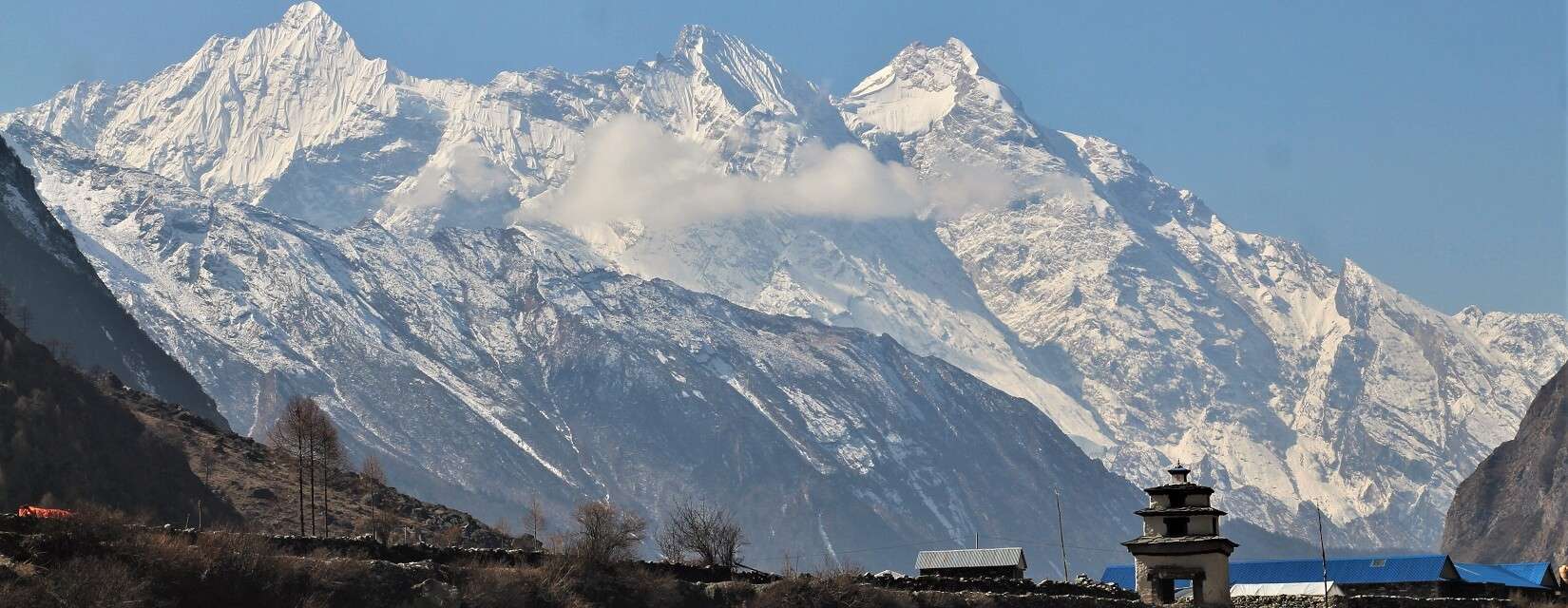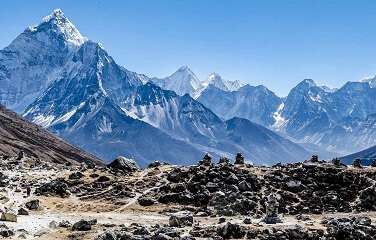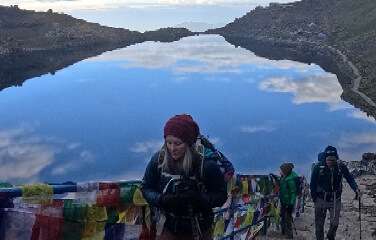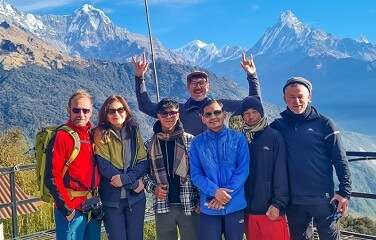Introduction to the Region

The Manaslu Circuit and Tsum Valley region is a part of the Manaslu Conservation Area. It shares a border with Tibet, and its cultural influences are deeply rooted in Tibetan Buddhism. The name “Tsum” is derived from the Tibetan word "Tsombo," meaning vivid. True to its name, the valley is vivid in natural beauty and cultural richness.
Opened to trekking in 2008, the Tsum Valley remains relatively unexplored compared to more popular trekking routes in Nepal. The valley is home to the majestic Ganesh Himal, Sringi Himal, and Boudha ranges, as well as ancient monasteries, mani walls, and lush alpine forests.
Highlights of the Manaslu Tsum Valley Trek
Remote Villages and Unique Culture
- Villages like Chhekampar and Nile give you a glimpse of traditional lifestyles. You’ll encounter locals speaking the Tibetan dialect and following ancient Buddhist traditions.
- The people here are warm and welcoming, often inviting trekkers into their homes for butter tea and local meals.
Sacred Monasteries
- The Mu Gompa and Rachen Gompa are among the most significant monasteries in the region. They offer insights into spiritual practices and are set against a stunning Himalayan backdrop.
Pristine Nature
- The trek passes through dense rhododendron and pine forests, cascading waterfalls, and raging rivers. The valley is also home to rare wildlife, including the elusive snow leopard and Himalayan blue sheep.
Breathtaking Mountain Views
- The trek offers panoramic views of peaks like Mt. Manaslu (8,163m), Ganesh Himal (7,422m), and other snow-clad giants.
Less Crowded Trails
- Unlike the Everest and Annapurna regions, the Tsum Valley trek is quieter, allowing trekkers to enjoy the solitude and peace of the Himalayas.
Manaslu Tsum Valley Itinerary
A typical Manaslu Tsum Valley trek takes about 18-21 days, depending on acclimatization and pace. Here's a sample itinerary:
Day 1: Arrival in Kathmandu (1,400m)
Day 2: Drive to Soti Khola (700m)
Day 3: Trek to Machha Khola (870m)
Day 4: Trek to Jagat (1,340m)
Day 5: Trek to Lokpa (2,240m)
Day 6: Trek to Chumling (2,386m)
Day 7: Trek to Chhekampar (3,031m)
Day 8: Trek to Nile (3,361m)
Day 9: Excursion to Mu Gompa (3,700m) and return to Nile
Day 10: Trek to Rachen Gompa (3,240m)
Day 11: Trek back to Lokpa (2,240m)
Day 12-16: Join the Manaslu Circuit Trek to Dharapani
Day 17: Drive to Kathmandu
Day 18: Departure
Best Time to Trek
- Spring (March-May): The valleys are blooming with rhododendrons, making the trails exceptionally beautiful.
- Autumn (September-November): Clear skies and perfect weather for mountain views.
Trek Difficulty and Preparation

The trek is considered moderately challenging, with daily walks of 5-7 hours on rugged terrain. Proper acclimatization is crucial as the trek involves high altitudes. Prior trekking experience is recommended but not mandatory. Ensure you're physically fit and well-prepared with gear and training.
Permits Required
- Manaslu Restricted Area Permit
- Tsum Valley Restricted Area Permit
- Manaslu Conservation Area Permit (MCAP)
- Annapurna Conservation Area Permit (ACAP)
All permits must be arranged through a registered trekking agency as the trek requires a licensed guide.
Accommodation and Food on the Trek
Teahouse Experience
The Manaslu Tsum Valley trek offers teahouse accommodation along the route. Teahouses are basic lodges that provide trekkers with a warm place to sleep and hearty meals. While facilities are not luxurious, they are comfortable enough for a remote trek. Here’s what to expect:
- Rooms: Typically, rooms are twin-shared with wooden beds, foam mattresses, and warm blankets. Some teahouses may have shared sleeping areas in the more remote sections of Tsum Valley.
- Facilities: Shared bathrooms with squat toilets are common. Hot showers (solar or gas-heated) are available for an extra fee.
- Electricity and Charging: Limited charging options are available, often at an additional cost. Bring a power bank to stay charged.
Meals
Teahouses serve traditional Nepali dishes alongside some Western options. Expect simple, filling meals:
Dal Bhat: A Nepali staple of lentil soup, rice, and vegetables. It's an all-you-can-eat meal, perfect for fueling a trekker's energy.
Tibetan Bread: A fried flatbread, great for breakfast or snacks.
Momos: Steamed dumplings stuffed with vegetables, meat, or cheese.
Porridge: A common breakfast option.
Snacks and Drinks: Hot tea, black coffee, and instant noodles are widely available. Carry some high-energy snacks like nuts and chocolate for the trail.
Flora and Fauna in the Manaslu Tsum Valley
The trek is not just a cultural journey but also a dive into the region’s ecological diversity. As you ascend through the valley, the landscape transitions from subtropical forests to alpine meadows.
Flora
- Forests: Lower altitudes are dominated by bamboo, pine, and rhododendron forests. In spring, the rhododendrons bloom in vivid pinks and reds.
- Alpine Zones: Beyond 3,500 meters, the vegetation becomes sparse, with hardy shrubs and mosses clinging to the rocky terrain.
Fauna
The Tsum Valley is a conservation haven, home to diverse wildlife:
- Snow Leopard: Elusive and rarely seen, but the area is one of its prime habitats.
- Himalayan Tahr: Agile mountain goats are often spotted on steep slopes.
- Langurs and Monkeys: Playful groups inhabit the lower forests.
- Birds: Keep an eye out for Himalayan monals, blood pheasants, and golden eagles.
Cultural Insights: Festivals and Practices

Festivals
If you’re trekking during festival season, you’ll witness vibrant local celebrations:
- Lhosar: The Tibetan New Year, celebrated with dances, prayers, and feasts.
- Mani Rimdu: A spiritual festival featuring masked dances performed by monks.
Buddhist Practices
Buddhism is deeply ingrained in Tsum Valley’s daily life. You’ll encounter:
- Chortens and Mani Walls: Stone walls inscribed with prayers, which you must always pass on the left.
- Prayer Flags: Colorful flags fluttering in the wind, carrying prayers to the heavens.
- Monasteries: Join a monk in meditation for a peaceful retreat from the physical challenges of trekking.
Packing List for the Manaslu Tsum Valley Trek
A well-prepared packing list ensures you’re equipped for varying weather and terrains. Here’s a checklist:
Clothing
- Base layers (thermal tops and bottoms)
- Trekking shirts (quick-dry)
- Insulated jacket (down or synthetic)
- Waterproof and windproof outer shell
- Trekking pants
- Warm hat, gloves, and neck gaiter
- Comfortable trekking boots and spare laces
- Warm socks (woolen) and liners
Gear
- Sleeping bag (rated for -10°C or lower)
- Trekking poles
- Headlamp with spare batteries
- Backpack (40-50L) with a rain cover
- Reusable water bottles and a purification system
Miscellaneous
- First aid kit (with altitude sickness medication)
- Sunscreen and lip balm (SPF 50+)
- Snacks and energy bars
- Camera or smartphone for photos
- Copies of permits and ID
Sustainable Trekking: Leave No Trace
The beauty of the Manaslu Tsum Valley is its untouched nature, and trekkers play a key role in preserving it. Here are tips for responsible trekking:
- Carry Trash: Bring all waste back to Kathmandu for proper disposal.
- Use Reusable Bottles: Avoid plastic bottles; purify local water instead.
- Respect Local Customs: Follow cultural etiquette, especially in monasteries.
- Stick to Trails: Avoid damaging fragile ecosystems by straying off paths.
Why the Manaslu Tsum Valley Trek Stands Out
The Manaslu Tsum Valley Trek isn’t just about reaching high altitudes or ticking off another Himalayan adventure. It’s about immersion—into a way of life, a pristine environment, and a journey that feels untouched by time. The combination of serene landscapes, cultural authenticity, and fewer trekkers makes this trek an unparalleled experience.
Whether you’re seeking spiritual tranquility, the thrill of rugged trails, or the joy of discovering a remote Himalayan paradise, the Manaslu Tsum Valley trek is bound to leave you with memories for a lifetime.
Route Specifics: Combining Tsum Valley with the Manaslu Circuit

For those seeking an extended adventure, the Manaslu Tsum Valley trek is often combined with the Manaslu Circuit Trek. This adds variety and elevates the overall trekking experience. Here's a breakdown of what to expect:
Tsum Valley Segment
- Unique Attractions: The Tsum Valley is culturally distinct, offering trekkers a deeper dive into Tibetan Buddhism and isolated communities.
- Highlights: Ancient monasteries like Mu Gompa (the highest monastery in the region) and Rachen Gompa, as well as sacred caves like the Milarepa Piren Phu Cave.
- Terrain: The valley’s trails are less rugged compared to the Manaslu Circuit, making it a calmer introduction to the trek.
Manaslu Circuit Segment
- Challenge: The trek ascends to Larkya La Pass (5,160m), a demanding yet rewarding high-altitude crossing.
- Mountain Views: Exceptional vistas of Manaslu (8,163m), the eighth-highest mountain in the world, and other peaks like Himlung and Cheo Himal.
- Cultural Shift: While Tsum Valley emphasizes Tibetan Buddhist culture, the Manaslu Circuit explores diverse ethnic groups like the Gurung and Nubri communities.
Combining the two treks requires proper acclimatization and additional days (usually 21–24 days in total).
Cultural History and Legends
The Tsum Valley has a fascinating history tied to Tibetan Buddhism and Himalayan lore. Locals believe it to be one of the “hidden valleys” or “Beyul”, prophesized by Guru Rinpoche as a sanctuary in times of turmoil. The valley served as a spiritual retreat for monks and lamas, including the legendary Milarepa, who is said to have meditated in the Piren Phu Cave.
Daily Life in Tsum Valley
The valley’s residents, the Tsumba people, have preserved a way of life largely untouched by modernity. Here are some unique aspects of their daily lives:
- Polyandry: Traditionally, the region practiced polyandry, where brothers in a family share a single wife, a system designed to preserve farmland and resources.
- Agriculture: The valley is self-sustaining, with locals growing barley, wheat, and potatoes. Yak herding is also common.
- Festivals: Monasteries host vibrant festivals like Dharma celebrations, where monks perform masked dances to honor Buddhist teachings.
Accessibility and Remote Feel
The trek begins with a drive from Kathmandu to Soti Khola, a 7–8-hour journey that introduces you to rural Nepal’s terraced fields and river valleys. Once the trek starts, the remoteness becomes apparent:
- Communication: Mobile networks are limited, and only some villages have access to basic Wi-Fi. This adds to the trek’s appeal as a digital detox.
- Supplies: Everything in the region is carried by porters or mules. It’s crucial to pack responsibly, as resupply options are minimal.
Wildlife Exploration
The Manaslu Conservation Area Project (MCAP) and the Tsum Valley Restricted Area are sanctuaries for Himalayan wildlife. Some of the unique species you may encounter include:
- Himalayan Blue Sheep: Often spotted grazing on high-altitude pastures.
- Red Panda: Though rare, the lush forests of the lower altitudes are their habitat.
- Golden Jackal: A stealthy predator occasionally seen along the trails.
- Birdlife: Over 100 species, including colorful pheasants, Himalayan vultures, and the iconic Danphe (Himalayan Monal).
Challenges and Rewards

Challenges
- Altitude Sickness: Gradual acclimatization is critical, especially in Tsum Valley and while crossing Larkya La Pass.
- Basic Facilities: Accommodations and meals are simple compared to more developed trekking routes.
- Long Hours of Trekking: Days can stretch to 6–8 hours, requiring physical endurance.
Rewards
- Authenticity: The trek’s remoteness keeps it authentic and less commercialized.
- Connection: You’ll build a unique connection with the locals and their way of life.
- Serenity: The tranquil landscapes and spiritual ambiance offer a meditative experience.
Tips for the Trek
- Hire a knowledgeable guide to navigate the restricted areas and learn about the local culture.
- Carry cash, as ATMs are unavailable in the region.
- Respect local customs, including seeking permission before photographing people or religious sites.
Why Choose the Manaslu Tsum Valley Trek?
For those seeking an off-the-beaten-path adventure, the Manaslu Tsum Valley Trek is unparalleled. It’s an opportunity to explore untouched landscapes, immerse yourself in Tibetan culture, and witness the raw beauty of the Himalayas without the crowds.
This trek combines the best of cultural immersion and natural splendor, making it an unforgettable journey. So, pack your bags and set out to discover one of Nepal's most enchanting regions.





